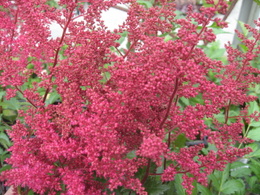Astilbe Growing Guide
Astilbe is a hardy perennial that is commonly known as false spirea or false goat’s beard. It is native to parts of North America and Asia and will do well in USDA Zones 4 to 8.
Plants are very easy to grow and will reward you with many years of attractive plume-like flowers in delicate shades of red, pink and white that appear in summer through fall. They reach an average height of 12 to 36-inches and spread 12 to 18-inches depending on the variety. It will look best when planted in groups.
In addition to being deer resistant astilbe are a nectar plant for butterflies, and pollinators.
They tend to burn in full sun and will do best in 4 to 6-hours of part sun. Blooming will be reduced in deep shade. Coral Bells, Hosta and Ferns are good companion plants for astilbe.
Starting from Seed
Astilbe seeds are short-lived and are difficult to germinate. The seeds need light to germinate and should be just pressed into the seed starting mix without covering. Germination may take 4 to 6-weeks.
For more detailed information visit the seed starting page.
It is better to plant divisions from other astilbe plants. They are available as bare root and in pots.
Soil Preparation
Plant your astilbe in part sun in a nice loose well-drained garden soil. They will do best with early morning and afternoon sun.
Planting
Plant them after the last expected frost 12 to 18-inches apart or in groups of 3 or 5. Dig a hole as deep as the pot and twice as wide. To the soil you just removed add the same amount of good garden soil so you have a nice blend of new and native soil.
Take the astilbe out of the pot and gently loosen the root ball pulling away any roots that have grown in a circle around the pot.
Place the root ball in the hole with the growing crown of the astilbe even with or an inch higher than the surrounding soil. Gently spread out the roots and back fill the hole around the root ball leaving a shallow depression around your plant. Fill the depression with water to settle the soil around the roots adding more soil if necessary and water again. Water daily tapering off as the astilbe roots grow and get established.
Plant the root divisions 1 to 2-inches deep with the roots down and the eyes, which may have started to sprout up.
They may also be planted in a container 14 to 16-inches wide and about 12-inches deep in a good quality potting soil.
Watering and Care
They are low maintenance and easy to care for. All you need to do is add a layer of mulch to help retain moisture and keep out competing weeds. During dry spells give some water to keep the soil moist.
They will also benefit from a light side dressing of organic fertilizer placed around the plant in the spring. Look for a fertilizer that has a higher phosphorus content, which is the second number on the NPK label.
Dividing Your Plants
After many years the center of the mature plant may die out, leaving the newer growth from the rhizomes. It usually becomes most apparent after a hard frost hits and the center becomes visible.
Doing the divisions every 3 to 5-years helps to rejuvenate the plant. To help prevent the spread of disease you should disinfect your garden tools and knife with a 10% bleach solution.
In the early spring about 4 to 6-weeks before the last frost date occurs and before growth begins, you can divide the clump into two, three or four sections.
Some gardeners will use a knife or a shovel to slice off a portion of the plant. A better way is to dig up the entire plant. Now you can see what you have. If you wash the soil off of the roots the entire rhizome and root structure can be seen.
Examine the rhizomes for the eyes or growing buds and carefully try to break it apart with your hands and then tease the roots apart. If necessary use a knife to separate the rhizomes.
You will now have more new plants that are identical to each other to replant or give away.
Diseases and Pests
Astilbe is usually pest and disease resistant, but occasionally it can develop powdery mildew or bacterial leaf spots. Many disease problems can be minimized by watering early in the day and avoiding water from getting on the plant’s leaves.
Tarnished plant bugs are an occasional problem in some areas. They use their needle-like mouth parts to suck out plant juices. Insecticides can be used or they can be hand-picked and dropped into a container with a few drops of dish soap. Holding the container of soapy water under the tarnished plant bug and tapping on the leaf or flower will cause it to drop into the container.
Popular Astilbe Varieties
Popular varieties: Bridal Veil, Fanal, Fireberry, Japonica Montgomery, Peach Blossom, Younique Silvery Pink.
Sources: Burpee, Eden Brothers, Harris Seeds
Garden Spikes newsletters give you timely information once or twice a month. Subscribe Free to the Garden Times newsletter below.
Your email address will only be used to send you a newsletter and will never be sold. You can unsubscribe at any time.

